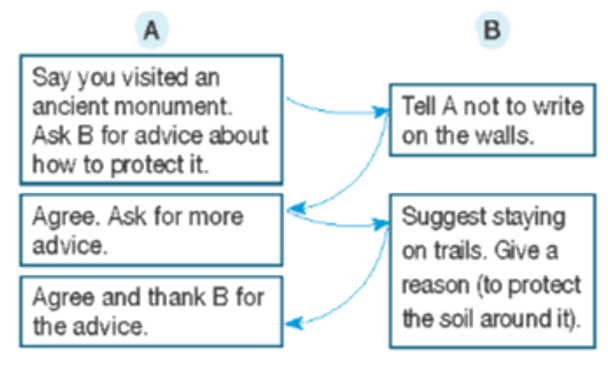Fill in each gap with take, touch, make, volunteer, reduce, cross, stay or drop. Then listen and check. (Điền vào mỗi khoảng trống với các từ take, touch, make, volunteer, reduce, cross, stay hoặc drop. Sau đó lắng nghe và kiểm tra.)
Heritage is something passed down from previous generations. It represents our history and our identity. It shows the link between our past, present and future. It is important to protect the heritage of the places we visit. Here are some simple ways.
Preserve natural heritage
(landscapes and wildlife)
1. __________________ on trails
2. don’t __________________ a lot of noise
3. _______________ to help with conservation projects
4. donate to a wildlife charity
5. __________________ your carbon footprint
Preserve cultural heritage
(architecture and monuments)
6. don’t __________________ litter
7. wear flat shoes with soft soles when you visit
8. don’t _____________ barriers
9. don’t ____________ surfaces
10. don’t ___________ souvenirs (pieces of stone, etc.)
Fill in each gap with take, touch, make, volunteer, reduce, cross, stay or drop. Then listen and check. (Điền vào mỗi khoảng trống với các từ take, touch, make, volunteer, reduce, cross, stay hoặc drop. Sau đó lắng nghe và kiểm tra.)
Heritage is something passed down from previous generations. It represents our history and our identity. It shows the link between our past, present and future. It is important to protect the heritage of the places we visit. Here are some simple ways.
Preserve natural heritage
(landscapes and wildlife)
1. __________________ on trails
2. don’t __________________ a lot of noise
3. _______________ to help with conservation projects
4. donate to a wildlife charity
5. __________________ your carbon footprint
Preserve cultural heritage
(architecture and monuments)
6. don’t __________________ litter
7. wear flat shoes with soft soles when you visit
8. don’t _____________ barriers
9. don’t ____________ surfaces
10. don’t ___________ souvenirs (pieces of stone, etc.)
Quảng cáo
Trả lời:
|
1. stay |
2. make |
3. volunteer |
5. reduce |
|
6. drop |
8. cross |
9. touch |
10. take |
Hướng dẫn dịch:
Di sản là thứ được truyền lại từ các thế hệ trước. Nó đại diện cho lịch sử và bản sắc của chúng ta. Nó cho thấy mối liên hệ giữa quá khứ, hiện tại và tương lai của chúng ta. Điều quan trọng là phải bảo vệ di sản của những nơi chúng ta đến thăm. Dưới đây là một số cách đơn giản.
Bảo tồn di sản thiên nhiên
(phong cảnh và động vật hoang dã)
1. giữ gìn đường mòn
2. đừng gây ồn ào
3. tình nguyện giúp đỡ các dự án về bảo tồn.
4. quyên góp cho một tổ chức từ thiện về động vật hoang dã
5. giảm lượng khí thải carbon
Bảo tồn di sản văn hóa
(kiến trúc và di tích)
6. không xả rác
7. đi giày bệt với đế mềm khi bạn ghé thăm
8. không vi phạm quy tắc
9. không chạm vào bề mặt
10. không lấy đồ lưu niệm (mảnh đá, v.v.)
Hot: 1000+ Đề thi cuối kì 1 file word cấu trúc mới 2025 Toán, Văn, Anh... lớp 1-12 (chỉ từ 60k). Tải ngay
- Trọng tâm Lí, Hóa, Sinh 10 cho cả 3 bộ KNTT, CTST và CD VietJack - Sách 2025 ( 40.000₫ )
- Trọng tâm Toán, Văn, Anh 10 cho cả 3 bộ KNTT, CTST, CD VietJack - Sách 2025 ( 13.600₫ )
- Sách lớp 10 - Combo Trọng tâm Toán, Văn, Anh và Lí, Hóa, Sinh cho cả 3 bộ KNTT, CD, CTST VietJack ( 75.000₫ )
- Sách lớp 11 - Trọng tâm Toán, Lý, Hóa, Sử, Địa lớp 11 3 bộ sách KNTT, CTST, CD VietJack ( 52.000₫ )
CÂU HỎI HOT CÙNG CHỦ ĐỀ
Lời giải
A: I visited an ancient temple yesterday. It’s so beautiful, but no one looks after it. What do you suggest to protect it?
B: My advice is not to write on the walls of the ancient temple.
A: Good point. Have you got any other suggestions?
B: Well, have you thought about staying on the paths when you visit? That way, you won’t damage the soil around it.
A: That’s good thinking. Thanks!
Hướng dẫn dịch:
A: Tớ đã đến thăm một ngôi đền cổ ngày hôm qua. Nó rất đẹp, nhưng không ai trông nom cả. Cậu có ý tưởng gì để bảo vệ nó không?
B: Tớ nghĩ không viết lên các bức tường của ngôi đền cổ.
A: Nói hay đấy. Cậu có gợi ý nào khác không?
B: À, cậu đã nghĩ đến việc giữ gìn con đường khi ghé thăm chưa? Bằng cách đó, cậu sẽ không làm hỏng đất đai xung quanh.
A: Đó là ý kiến hay đấy. Cảm ơn!
Lời giải
Some more ways to protect our national heritage are to protect natural wildlife, arrange clean-up days and avoid touching ancient ruins.
Hướng dẫn dịch:
Một số cách để bảo vệ di sản quốc gia của chúng ta là bảo vệ động vật hoang dã tự nhiên, sắp xếp các ngày dọn dẹp và tránh chạm vào các di tích cổ.
Lời giải
Bạn cần đăng ký gói VIP ( giá chỉ từ 199K ) để làm bài, xem đáp án và lời giải chi tiết không giới hạn.
Lời giải
Bạn cần đăng ký gói VIP ( giá chỉ từ 199K ) để làm bài, xem đáp án và lời giải chi tiết không giới hạn.
Lời giải
Bạn cần đăng ký gói VIP ( giá chỉ từ 199K ) để làm bài, xem đáp án và lời giải chi tiết không giới hạn.
